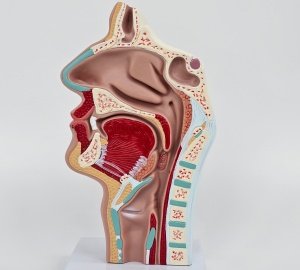
Dr. Ewan Harrison from the Wellcome Sanger Institute and the University of Cambridge is leading research into the upper respiratory microbiome, focusing on how bacterial pathogens colonise it and how this knowledge can inform vaccine development and infection prevention strategies. His work, which he presented at the Festival of Genomics & Biodata 2025, centres on the microbiome of the nostrils, nasopharynx, and pharynx, which are critical sites for bacterial colonisation and viral infections.
The role of Staphylococcus aureus and other pathogens
One of the primary bacterial pathogens of interest is Staphylococcus aureus, a major human pathogen responsible for the largest number of bacterial infection-related deaths. Understanding its basic biology and why some individuals carry it persistently while others do not is a key research goal. Carriers of S. aureus are at an increased risk of infection, and colonisation can contribute to outbreaks, particularly in hospital settings. However, paradoxically, carriers are also less likely to die from an infection, suggesting potential benefits of colonisation.
Carrier status varies: some people are persistent carriers, some are intermittent carriers, and about 50% of the population are non-carriers. The determinants of this status remain unclear, but environmental factors and genetics appear to play significant roles. The concept of intermittent carriers is being scrutinised, as they may not represent a distinct group but rather a misclassification of persistent or non-carriers.
The nasal microbiome and S. aureus colonisation
Research into the nasal microbiome has revealed that persistent carriers of S. aureus have lower alpha diversity, meaning fewer bacterial species dominate the microbiome. In these individuals, S. aureus outcompetes other bacteria. Beta diversity analysis shows that microbiomes cluster according to colonisation status, with persistent carriers having distinct microbial compositions. Intermittent carriers exhibit microbiome profiles that fluctuate between those of persistent carriers and non-carriers.
A large carriage study recruited 22,500 blood donors to assess how blood donation might impact S. aureus colonisation. Participants provided three nasal swabs over time for DNA extraction and microbiome analysis. The study initially employed 16S amplicon sequencing due to the low bacterial load in nasal samples and the risk of contamination. Now, deeper shotgun sequencing is being pursued for more detailed insights.
Predicting carrier status and infection risk
Analysing microbiome profiles has enabled researchers to predict persistent carrier status accurately. This predictive capability could lead to risk profiling in healthcare settings, allowing for tailored infection prevention strategies. Future work will refine this model through deeper sequencing and analysis.
Findings suggest that only two microbiome states exist—persistent carriers and non-carriers—while intermittent carriers do not form a distinct category. Instead, they are misclassified individuals with fluctuating microbiome profiles. This has significant implications for microbiome-based risk assessment and infection control strategies.
Investigating respiratory viruses and microbiome interactions
In addition to bacterial pathogens, Dr Harrison’s research extends to respiratory viruses. Using a metagenomic bait capture approach, his team is probing libraries targeting viruses such as influenza, COVID-19, and respiratory syncytial virus (RSV). The SIREN study, which collects nasal swabs every two weeks from healthcare workers across England, is being leveraged to sequence these viruses and identify co-infections.
Now, this technology is being applied to samples from 2023-2024, collected from individuals with respiratory symptoms who tested negative for the primary three viruses. Sequencing these samples will help identify other viral contributors to respiratory disease and generate full-length viral genomes for genomic surveillance.
Future directions: integrating bacterial and viral research
The next phase of research aims to integrate bacterial and viral datasets to understand how viral infections impact the microbiome and vice versa. This could reveal how an individual’s microbiome composition influences their susceptibility to viral infections and how microbial communities might offer protective effects. Such insights could revolutionise approaches to infection prevention and treatment, ultimately improving public health outcomes.
Dr Harrison’s work represents a critical step forward in microbiome research, shedding light on the intricate relationships between bacterial colonisation, viral infections, and human health.
